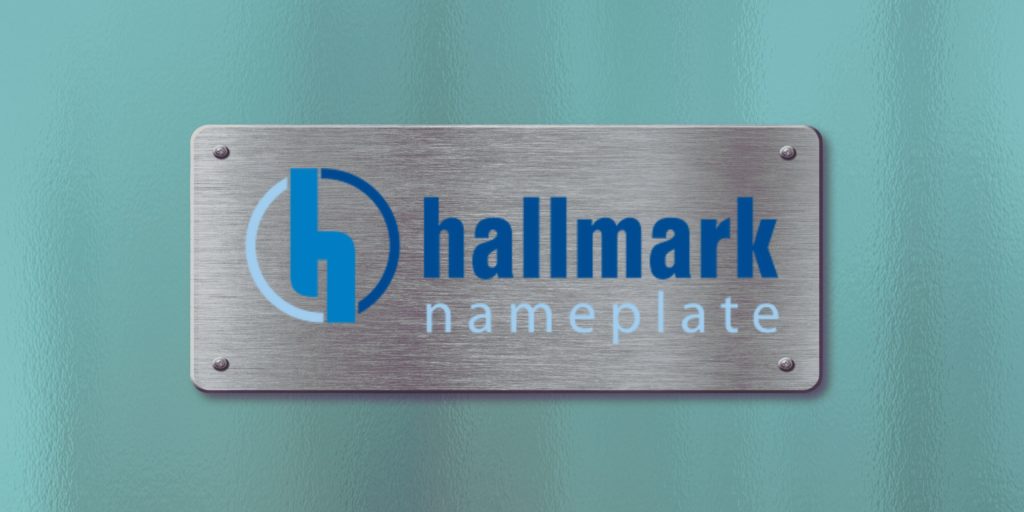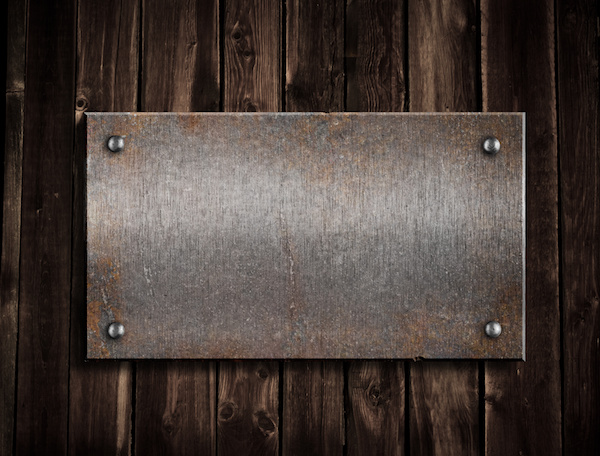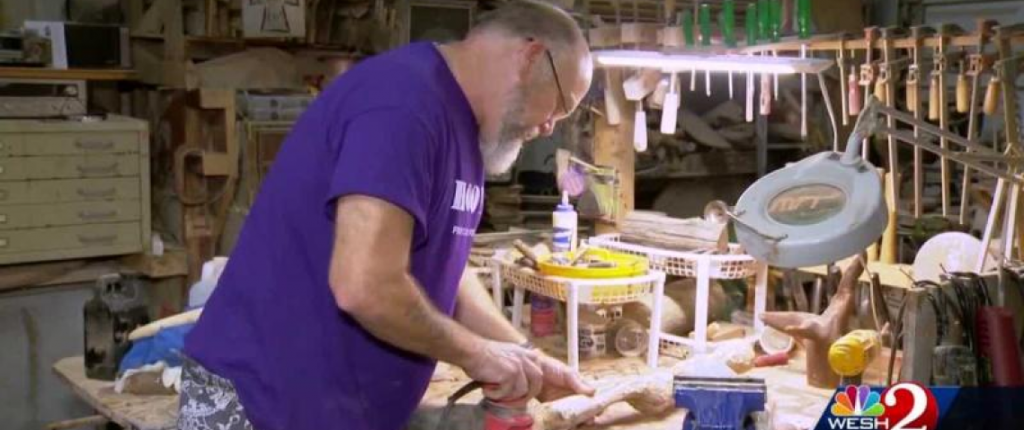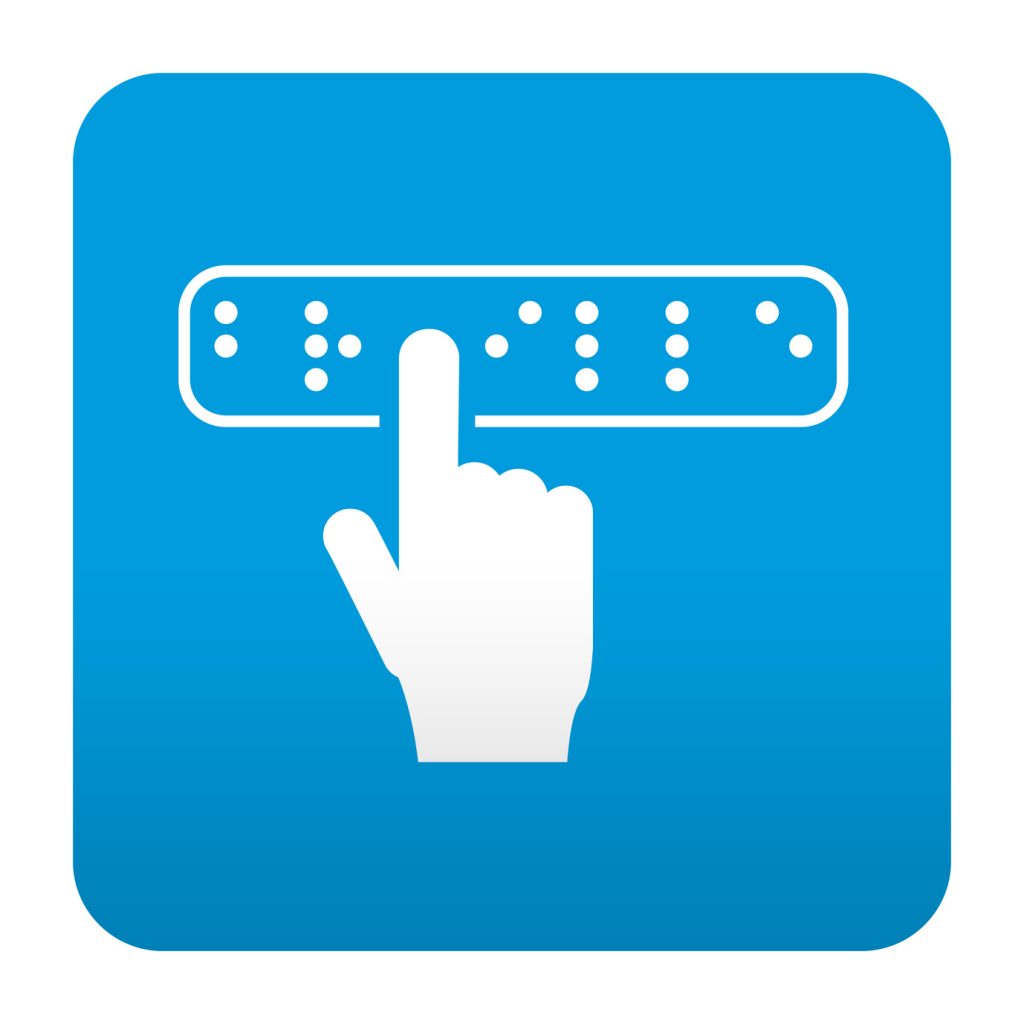What comes to mind when you think of something durable, versatile, and fully customizable? While metal nameplates might not be the first thing you think of, they play a crucial role in our daily lives and many industries.
From branding and safety to identification and tracking, these nameplates may seem unassuming, but their importance should not be understated. They convey information effectively and with a lasting impact for many applications such as automotive, food service, aerospace, manufacturing, construction, and many more.
So, whether you’re a business owner seeking the perfect branding solution or just appreciating the beauty and functionality of metal nameplates, this blog is your guide to understanding their diverse uses in different industries. Join us in dissecting the types of metal nameplates and their applications, so you too can become a nameplate expert.
Let’s dive in!
What Are Metal Name Plates Used For?
Before we examine the specifics of these metallic marvels, let’s establish a basic understanding of what metal nameplates are used for. Metal nameplates serve a diverse range of purposes due to their durability, versatility, and customizable nature.
These nameplates are typically made from materials such as aluminum, stainless steel, brass, or other metals to make them suitable for a wide array of applications. Keep reading to learn what purposes metal nameplates are used for.
Identification
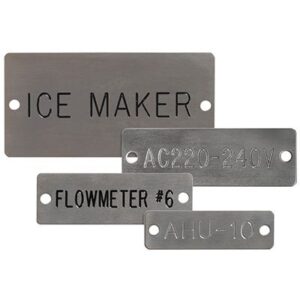
From employee badges to product labeling, metal nameplates provide a durable and customizable solution for communicating information clearly and efficiently.
- Employee identification: Metal nameplates are often used for employee identification in various business settings. They can include the employee’s name, position, and sometimes the company logo to contribute to a professional and organized work environment.
- Product identification: Manufacturers utilize metal nameplates to label products with essential information such as serial numbers, model details, and manufacturing dates. This aids in product traceability and helps customers identify genuine products.
Tracking & Inventory
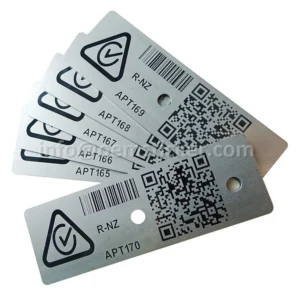
Metal nameplates play an integral role in tracking and inventory management. They label assets with unique identifiers, barcodes, or QR codes to ensure seamless organization and control.
- Asset tracking: Metal nameplates are valuable for tracking assets within a company, such as equipment, machinery, or tools. The inclusion of barcodes or QR codes on these nameplates facilitates efficient asset management and inventory tracking.
- Serial numbers: For items that require unique identification, metal nameplates are often used to display serial numbers. This is crucial for tracking and managing inventory in the manufacturing, logistics, and distribution industries.
Instruction

Nameplates are also a great way to provide instructions for machines and products that can withstand many types of environmental conditions. They won’t rub off or become hard to read over time, so nameplates are often used in settings that are very active, like construction, manufacturing, fitness, etc.
- Machine operation instructions: In industrial settings, metal nameplates are employed to display essential operating instructions and safety guidelines for machinery and equipment. This ensures that operators have clear instructions on proper usage, contributing to workplace safety.
- Product usage guidelines: Metal nameplates can also be used on consumer products to provide usage instructions, maintenance guidelines, or safety precautions. This is particularly common in industries such as electronics and appliances.
Safety
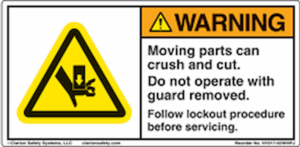
In order to ensure safe working conditions, organizations often use metal nameplates to convey safety instructions and warning labels that can tolerate harsh conditions.
- Warning labels: Metal nameplates serve as durable warning labels for machinery, chemicals, and other potentially hazardous materials. These labels often include symbols, text, or color-coding to convey safety information and promote a secure working environment.
- Emergency evacuation plans: In buildings and facilities, metal nameplates are utilized to display emergency evacuation plans, fire escape routes, and safety procedures. These nameplates are often made from materials resistant to environmental conditions, ensuring they remain legible in emergencies.
Branding
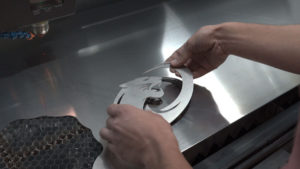
In addition to practical uses, nameplates also add to an aesthetic appeal for branding. Clean-cut lines and shiny finishes on nameplates can contribute to organizations’ branding and create further brand recognition.
- Corporate branding: Metal nameplates can be customized with a company’s logo, tagline, or other branding elements. These nameplates are often used on office doors, desks, and entrance areas to reinforce corporate identity.
- Product branding: Manufacturers use metal nameplates to enhance the branding of their products. These nameplates contribute to a polished and professional appearance, elevating the perceived value of the product in the eyes of the consumer.
Popular Metal Nameplate Options
When it comes to metal nameplates, the material chosen plays a pivotal role in determining its durability, appearance, and functionality. In this section, we’ll delve into some popular metal options, exploring their unique characteristics and applications.
Stainless Steel
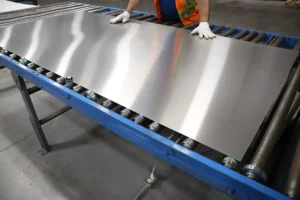
Stainless steel, renowned for its resilience and corrosion resistance, finds its way into a variety of metal nameplate applications. From military place cards to control panels, its strength and tarnish-proof nature set it apart. There are three main classifications:
1. Austenitic
Austenitic stainless steel is the most commonly used alloy, and it is a part of the 200 and 300 series number. Typically, it is composed of nickel and chromium. This type of stainless steel is perfect for welding and is corrosion-resistant.
2. Ferritic
Ferritic stainless steel is an alloy with low nickel content, which makes it one of the more affordable types of stainless steel. It is most popular for indoor environments where aesthetic appeal is not as pertinent. Ferritic stainless steel is also corrosion-resistant and great for welding, and it falls in the 400 series.
3. Martensitic
Martensitic stainless steel is less common and can be moderately resistant to corrosion. Similar to ferritic steel, it belongs to the 400 series grade and remains magnetic after annealing. This type of steel is often used in medical applications.
Aluminum
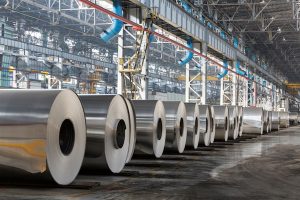
Aluminum is a very popular metal nameplate option because it is highly versatile, durable, and lightweight. Since it is non-ferrous and can be combined with metals like zinc and copper, these alloys are ideal for industrial use because they can withstand harsh environments and heavy use.
It can be used for both indoor and outdoor applications and has a hard, attractive finish. Equipment asset tags are commonly composed of aluminum.
The different series of aluminum alloys have different recommended applications. For example, the 2,000 series is created to satisfy aerospace requirements, while the 5,000 series is often used for marine applications.
Aluminum Finishes
There are a few different types of aluminum finishes for metal nameplates, including anodized (sealed) aluminum, unsealed aluminum, and photosensitive aluminum.
- Anodized aluminum is lightweight, durable, and can be customized with colors and designs. These are typically used for instructional tags, serial numbers and corporate identity tags, scales, dials, templates, and rating plates.
- Unsealed aluminum, also known as undyed aluminum, is a porous finish that is designed to conform to military requirements and other specifications.
- Photosensitive aluminum finishes are used to create metal nameplates with high-resolution images that are durable and applicable for both indoor and outdoor use.
Brass
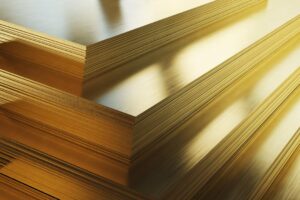
As an alloy constructed from copper and zinc, brass is also resistant to corrosion. Due to its red and gold hue, brass is often used for aesthetic purposes. For this reason, it is considered a type of red metal alloy.
In comparison to the alternative – classic gold nameplates – brass nameplates are more affordable and maintain the same decorative quality.
Since brass is a non-sparking material, it is commonly used for applications where sparking is a concern. Plumbing and electrical applications often employ brass materials.
Bronze
Like brass, bronze is also a red metal that is commonly used for decorative purposes. If you are looking for a nameplate with a more reddish hue, then bronze is the perfect choice.
This alloy is tarnish and rustproof, and it is composed of copper mixed with tin. Plus, it is resistant to saltwater corrosion, which makes it the ideal nameplate choice for seaside environments.
Some important characteristics of bronze to note relate to its density and malleability. Moreover, bronze is commonly used for custom bronze plaques, badges, and signs.
How High-Quality Metal Nameplates Are Created
Now that we know the uses and different materials of nameplates, let’s do a brief overview of how they are created.
1.) Material Selection
The process begins with choosing the appropriate metal for the desired application. Whether it’s stainless steel for durability, aluminum for versatility, or brass for its aesthetic appeal, each material brings its own set of characteristics to the table.
2.) Design Phase
Once the material is selected, the design phase commences. Modern technologies like computer-aided design (CAD) software allow for intricate custom designs. This step involves considering the specific requirements, branding elements, and any regulatory or safety information that needs to be incorporated.
3.) Metal Fabrication and Laser Cutting Technology
The introduction of advanced machinery, such as the IPG Photonics LaserCube, has revolutionized the precision cutting of metal. Fiber lasers like the LaserCube swiftly and accurately translate digital designs into physical reality. This technology is particularly invaluable for intricate details, ensuring a clean and precise cut.
4.) Finishing Touches
Following the laser cutting process, the metal nameplates undergo finishing touches. This includes applying specific finishes like anodization for aluminum or adding a protective coating for enhanced durability. These final touches contribute not only to the visual appeal but also to the longevity of the nameplate.
5.) Customization
One of the distinct advantages of the modern fabrication process is the ability to customize and personalize each metal nameplate. Whether it’s incorporating company logos, unique designs, or specific information, this step allows for a tailored approach to meet diverse needs.
As you can see, the process of creating metal nameplates is very involved. To bring the exact vision to life, you need experts who can seamlessly craft your nameplate with precision and professionalism.
Get the Best Quality Metal Nameplates With Hallmark Nameplates
At Hallmark Nameplate, we’ve been trusted manufacturers of high-quality custom nameplates for over 60 years. Using cutting-edge technology like the IPG Photonics LaserCube, we ensure precision in crafting intricate designs.
Our custom metal nameplates are tailored to your specifications, and our expert guidance makes the process seamless. Order a product sample box to experience the look and feel of your unique nameplate.
Let us bring your vision to life – request a quote today!

